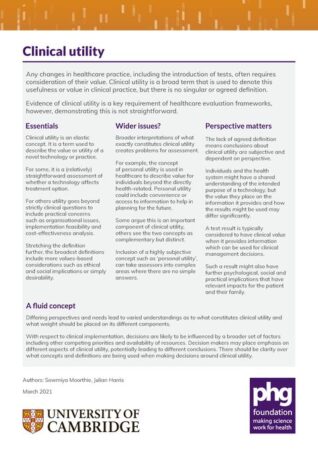Any changes in healthcare practice, including the introduction of tests, often requires consideration of their value. Clinical utility is a broad term that is used to denote this usefulness or value in clinical practice, but there is no singular or agreed definition.
Evidence of clinical utility is a key requirement of healthcare evaluation frameworks, however, demonstrating this is not straightforward.
Essentials
Clinical utility is an elastic concept. It is a term used to describe the value or utility of a novel technology or practice. For some, it is a (relatively)straightforward assessment of whether a technology affects treatment option.
For others utility goes beyond strictly clinical questions to include practical concerns such as organisational issues, implementation feasibility and cost-effectiveness analysis.
Stretching the definition further, the broadest definitions include more values-based considerations such as ethical and social implications or simply desirability.
Wider issues?
Broader interpretations of what exactly constitutes clinical utility creates problems for assessment.
For example, the concept of personal utility is used in healthcare to describe value for individuals beyond the directly health-related. Personal utility could include convenience or access to information to help in planning for the future.
Some argue this is an important component of clinical utility, others see the two concepts as complementary but distinct.
Inclusion of a highly subjective concept such as ‘personal utility’, can take assessors into complex areas where there are no simple answers.
Perspective matters
The lack of agreed definition means conclusions about clinical utility are subjective and dependent on perspective. Individuals and the health system might have a shared understanding of the intended purpose of a technology, but the value they place on the information it provides and how the results might be used may differ significantly.
A test result is typically considered to have clinical value when it provides information which can be used for clinical management decisions.
Such a result might also have further psychological, social and practical implications that have relevant impacts for the patient and their family.
A fluid concept
Differing perspectives and needs lead to varied understandings as to what constitutes clinical utility and what weight should be placed on its different components. With respect to clinical implementation, decisions are likely to be influenced by a broader set of factors including other competing priorities and availability of resources.
Decision makers may place emphasis on different aspects of clinical utility, potentially leading to different conclusions. There should be clarity over what concepts and definitions are being used when making decisions around clinical utility.
March 2021


